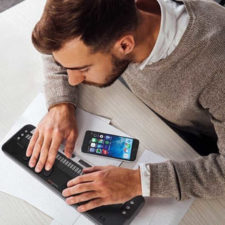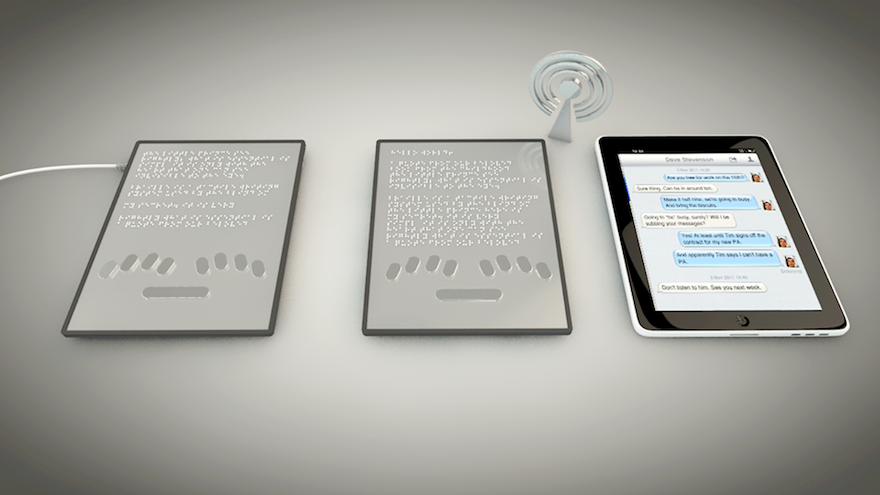AI-Powered Visual Aids: Redefining Support for the Blind
Discover Innovative Tools Designed for the Aesthetically Impaired
The development of ingenious devices for the visually damaged stands for a significant innovation in availability and freedom. Technologies such as wise glasses with AI abilities and mobile applications made to give acoustic summaries are improving everyday experiences for users. In addition, wearable tools that utilize haptic feedback enhance environmental awareness, while modern Braille technologies supply brand-new methods to involve with message. As these tools continue to progress, their influence on the lives of those with aesthetic impairments increases essential inquiries concerning the future of inclusivity and autonomy in different aspects of life. What lies ahead in this technical landscape?
Smart Glasses for Navigating

Smart glasses made for navigation are changing the means visually impaired individuals connect with their atmosphere. These advanced devices utilize a combination of video camera innovation, expert system, and auditory comments to offer real-time info regarding environments. By employing challenge discovery systems, clever glasses can alert individuals to prospective hazards, allowing safer movement in both unknown and familiar setups.
The integration of GPS technology better boosts navigation abilities, enabling users to obtain acoustic directions as they move. This hands-free strategy not only promotes independence but also encourages visually damaged people to browse metropolitan landscapes with raised confidence. In addition, numerous smart glasses are outfitted with functions that determine landmarks and road signs, offering contextual details that boosts the user experience.
Moreover, the advancement of these devices is continuously advancing, with companies functioning to enhance the precision of object acknowledgment and expand the array of navigational features. As smart glasses become more accessible and budget-friendly, they hold the potential to substantially transform day-to-day live for aesthetically damaged users. Inevitably, these ingenious tools stand for a vital action towards inclusivity, offering boosted wheelchair and a higher feeling of freedom for individuals browsing the world around them.

Mobile Application for Daily Living
Exactly how can mobile applications improve the lives of visually impaired people? Mobile applications are reinventing the way visually damaged customers navigate their atmospheres, handle everyday jobs, and access information. These applications give important support via different functionalities, cultivating self-reliance and improving lifestyle.
Numerous cutting-edge mobile applications are developed especially for daily living. Applications like Be My Eyes link visually damaged customers with sighted volunteers using video telephone calls, enabling them to get real-time help with tasks such as checking out tags or browsing unknown areas. Similarly, Seeing AI, developed by Microsoft, uses artificial knowledge to describe environments, checked out message, and recognize things, successfully transforming a mobile phone right into a powerful device for daily assistance.
Furthermore, navigation applications customized for the visually impaired, such as Aira and BlindSquare, provide audio-based directions and ecological info, enabling individuals to traverse their surroundings securely and confidently. Past navigating and instant support, mobile apps also sustain organization and job monitoring, with features that aid customers set tips, produce to-do listings, and track appointments. In summary, mobile applications offer as indispensable sources, equipping visually damaged individuals to lead more independent and fulfilling lives.
Wearable Technologies for Support
Empowerment with technology is progressively noticeable in the world of wearable gadgets designed to help aesthetically impaired people. These innovative tools incorporate perfectly right into life, improving navigating and supplying important comments to users. Clever glasses furnished with video cameras can identify faces and read text out loud, enabling individuals to engage even more confidently in professional and social settings.
One more noteworthy improvement is the use here of haptic feedback systems in wearable devices. These systems use resonances or other tactile signals to share information regarding the customer's setting, such as barriers or changes in terrain, boosting wheelchair and security. Wearable innovations also consist of wristbands that link to smartphones, notifying customers to notifications with subtle vibrations, therefore boosting connection without dependence on visual cues.
As these innovations proceed to evolve, they are not just improving independence for visually damaged individuals yet additionally cultivating a higher sense of addition in culture. By connecting the get more gap in between challenges faced in daily living and the capacity for autonomy, wearable innovations function as critical devices in the mission for equal rights and empowerment for those with visual impairments.
Audio Summary Devices
Sound description devices play a vital function in improving availability for aesthetically damaged individuals, giving them with the capability to engage with aesthetic media. OCR devices for the blind. These devices supply narrated descriptions of essential visual elements in movies, television shows, and live efficiencies, guaranteeing that users can totally comprehend the context and feelings shared with visuals
Audio description can be integrated into numerous platforms, including streaming solutions, movie theater testings, and live cinema. Numerous prominent streaming solutions currently include audio description as an accessibility attribute, permitting audiences to choose it conveniently. In addition to traditional media, specialized applications also exist, supplying audio descriptions for art exhibitions, galleries, and other cultural events.
The effectiveness of audio summary depends upon the ability of the storytellers, who have to communicate visual details succinctly without diminishing the original audio. Innovations in this field are also paving the means for more individualized experiences, where users can change the level of information and pacing according to their preferences.
Braille Innovations and Devices
Braille developments and tools have actually significantly transformed the means visually impaired people engage with text and information. Modern innovations have actually brought about the advancement of functional devices that improve proficiency and self-reliance among individuals. Notably, Braille display technologies have advanced, permitting for vibrant analysis experiences. These devices convert electronic message into Braille, making it possible for customers to access a vast selection find out here of information on mobile phones, computers, and tablet computers.
Moreover, portable Braille notetakers combine conventional Braille input with contemporary performances, promoting note-taking, scheduling, and document editing on the go. Braille displays and notetakers. These small tools commonly feature text-to-speech capacities, bridging the space in between Braille and auditory information
In enhancement, cutting-edge Braille printers have emerged, permitting customers to generate Braille tags, papers, and academic materials efficiently. This access fosters better involvement in expert and instructional settings, inevitably promoting inclusivity.
In addition, study right into smart Braille modern technologies proceeds to broaden. Instruments that incorporate expert system are being explored to supply real-time navigation aid and contextual details, enhancing the customer experience in varied setups. In general, these innovations show a commitment to empowering visually damaged individuals with innovation, guaranteeing they can easily accessibility and involve with the world around them.

Verdict
The innovation of innovative devices for the aesthetically damaged significantly enhances independence and lifestyle. Smart glasses, mobile applications, wearable technologies, audio summary tools, and Braille technologies jointly empower people by giving essential navigation aid, ecological recognition, and enhanced analysis experiences. These technologies not only foster greater addition however also promote freedom in day-to-day tasks, inevitably adding to an extra equitable and easily accessible society for visually damaged individuals. Proceeded growth in this area holds guarantee for more improvements.
As clever glasses end up being much more easily accessible and cost effective, they hold the possible to dramatically change everyday life for aesthetically impaired customers. Mobile applications are reinventing the way aesthetically damaged users navigate their atmospheres, manage day-to-day tasks, and accessibility information. Applications like Be My Eyes attach visually damaged customers with sighted volunteers via video clip telephone calls, enabling them to receive real-time aid with tasks such as reading tags or navigating unfamiliar spaces.Furthermore, navigating apps customized for the visually damaged, such as Aira and BlindSquare, supply audio-based instructions and environmental information, enabling individuals to traverse their surroundings safely and confidently.The improvement of ingenious tools for the visually impaired substantially enhances independence and top quality of life.